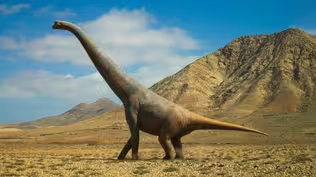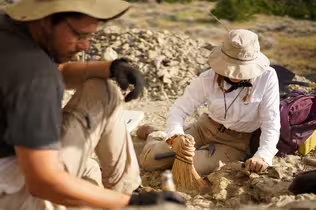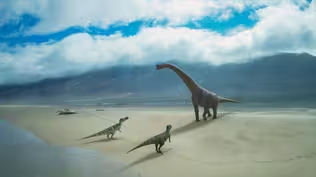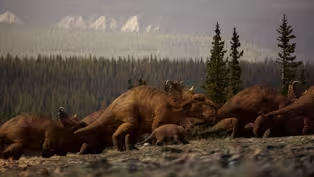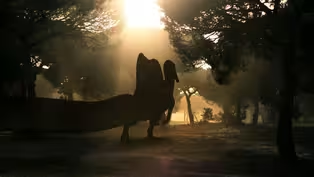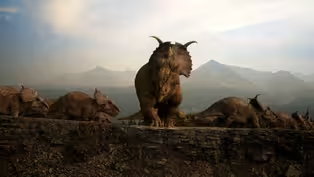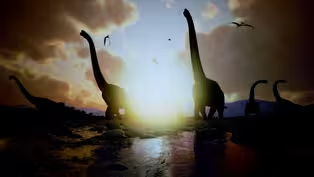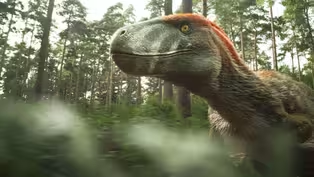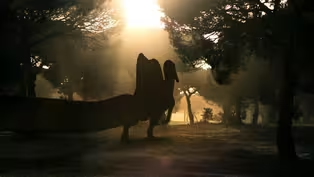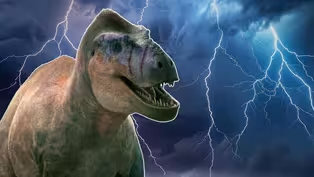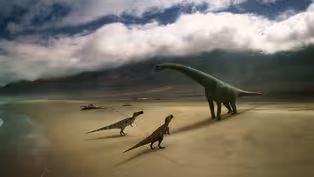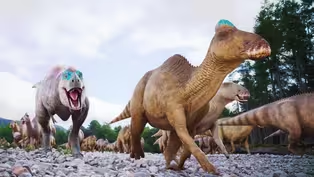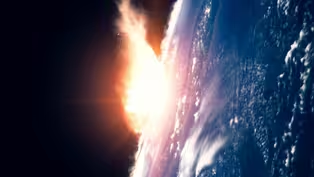
How an Evolutionary Arms Race Created Bizarre Dino Designs
Special | 5m 32sVideo has Closed Captions
It’s grudge match time. Except that this one took place over millions of years.
It’s attack vs defense on an epic evolutionary scale. Utahraptor was the largest raptor to ever walk the Earth, honing its weapons and tactics to become a truly apex predator. And top of Utahraptors’ dinner wish list was Gastonia. But Gastonia were the spikiest dinosaurs to ever lived, covered in thick armor and developing their own deadly weapons with which to fight back.
Problems playing video? | Closed Captioning Feedback
Problems playing video? | Closed Captioning Feedback
Narrator: Shane C. Campbell-Staton With Thanks: Utah State. University, Usu Eastern Prehistoric Museum, Utah Geological Survey, Bureau of Land Management Utah, Moab Field Office, Utah Dig Team Digital Producer &...

How an Evolutionary Arms Race Created Bizarre Dino Designs
Special | 5m 32sVideo has Closed Captions
It’s attack vs defense on an epic evolutionary scale. Utahraptor was the largest raptor to ever walk the Earth, honing its weapons and tactics to become a truly apex predator. And top of Utahraptors’ dinner wish list was Gastonia. But Gastonia were the spikiest dinosaurs to ever lived, covered in thick armor and developing their own deadly weapons with which to fight back.
Problems playing video? | Closed Captioning Feedback
How to Watch Walking with Dinosaurs
Walking with Dinosaurs is available to stream on pbs.org and the free PBS App, available on iPhone, Apple TV, Android TV, Android smartphones, Amazon Fire TV, Amazon Fire Tablet, Roku, Samsung Smart TV, and Vizio.
Providing Support for PBS.org
Learn Moreabout PBS online sponsorshipMore from This Collection
Check out our 12 digital exclusives from our series Walking with Dinosaurs with BBC.
When Dinosaurs Ruled the Arctic Circle
Video has Closed Captions
Very few dinosaurs made it as far North as the Arctic Circle...except for two. (5m 52s)
We Were Wrong About Spinosaurus
Video has Closed Captions
Millions of years ago, dinosaurs ruled the Earth. But underwater it was a totally different world. (6m 36s)
Were Dinosaur Brains Designed For Combat?
Video has Closed Captions
Did Pachyrhinosaurus bones always gather in such great numbers? (5m 42s)
How We Solve Jurassic Mysteries from One Bizarre Fossil
Video has Closed Captions
Would you lick a 65-million-year old dinosaur poop? (5m 19s)
How Walking with Dinosaurs Created the Most Accurate Dinos Ever
Video has Closed Captions
Join the team behind the scenes! (6m 32s)
How to Find a Dinosaur that Hollywood Dreamed Up
Video has Closed Captions
What would make a Utahraptor so much larger than other raptor species? (5m 50s)
How the Walking with Dinosaurs Team Brought a Dinosaur Back to Life
Video has Closed Captions
The Walking With Dinosaurs team reveal how they created the Spinosaurus. (5m 50s)
How Extreme Weather Is Revealing — And Destroying — Dinosaur Fossils
Video has Closed Captions
Imagine finding a rare fossil that you’ve been desperate to find - only for it to be put at risk. (5m 59s)
The Dinosaurs that Could Cross the Atlantic
Video has Closed Captions
How did dinosaur fossils get there? (5m 42s)
Did Dinosaurs Abandon Their Young to Help Them Survive?
Video has Closed Captions
In late Cretaceous Alberta, many apex predators roamed free, so how did the prey survive? (5m 45s)
Did a Meteor Kill All the Dinosaurs?
Video has Closed Captions
Did the asteroid kill the T. rex and Triceratops? (5m 42s)
Providing Support for PBS.org
Learn Moreabout PBS online sponsorship[Narrator] Evolution can sometimes appear like an arms race.
Each improvement by attack or defence then needs to be matched by the enemy.
This arms race took place over more than 20 million years, between the ferocious Utahraptor and its would-be prey, Gastonia.
-[Jim Kirkland] Here we had raptors and armoured dinosaurs here for 22 million years.
So, it was an arms race, both of offensive weapons and defensive.
-[Narrator] Over 135 million years ago, Utahraptor had taken advantage of an earlier extinction event.
In the absence of other major predators, Utahraptor ballooned in size, twice as long and up to 10 times heavier than the iconic Velociraptor.
making Utahraptors the largest raptors ever to walk the earth.
And suddenly, much bigger herbivores were on the menu, including Gastonia.
But Gastonia was far from defenseless.
-This is the spiniest dinosaur that probably ever lived.
-[Narrator] Palaeontologist Jim Kirkland has found hundreds of Gastonia bones across the Utah desert, all of which have revealed that this animal was armoured like a tank.
-Spines on their back, spines on their sides, spines on their tail.
And this animal, these elements seemed to be the biggest, you know, the spiniest of each one of these things.
-[Narrator] Gastonia's spikes would have made it a formidable target for any hungry Utahraptor.
And if that wasn't enough, these blades could overlap, slicing through attackers like a pair of scissors.
-You know, think of someone who try to protect themselves, you know, with a chainsaw blade on a handle.
The way they would swing their tail and the way these things would crisscross, you know, these things would chop into a predatory animal because their tail is so powerful.
You know, a slash into a predatory animal the neck, the head, you know, cause extreme damage and they would back off.
-[Narrator] To take down such a formidable opponent, Utahraptor had to up its game.
And luckily for them, they had both a deadly weapon and cunning tactic to shift the odds back in their favor.
If they were able to flip Gastonia over, they'd render them defenseless, exposing their softer underbelly, which Utahraptor would swiftly rip to shreds with its 10-inch claws.
Predatory tactics like this would have required complex cooperation between different raptors.
And luckily for them, Utahraptors were highly intelligent, which we can tell by looking at their brain case.
-[Jim] Look at the size of this.
It's about the size of a parrot's brain.
And you figure how intelligent a parrot is.
This was a very smart dinosaur, no doubt.
-[Narrator] Advantage, Utahraptor.
But Gastonia wasn't going to take this lying down.
And the benefit of ganging up was not lost on them either.
Most armoured dinosaurs seem to have lived solitary lives, but Gastonia developed the skull of a distinctly social animal, which indicates that they grouped together for protection.
-[Jim] You know, when you put the head in right position, just tilt it down a bit, the eyes can look right at you for it.
You know, look them in the eye.
Plant eating animals rarely do that.
-[Narrator] And for a dinosaur that wouldn't have been able to run away, this could have been essential in tipping the balance back in their favor.
But just when it looked like this arms race was heading for a stalemate, Gastonia had one more trick up its sleeve.
Because Jim thinks that not only did they group together, they fought together.
Like an elite military unit, they turned inwards to face each other so they could coordinate their movements.
-They could have had inflatable nasal sacs, chambers and things in there so that then they could vocalise and probably very distinctly and be able to, you know, look at each other and probably make, you know, signals.
-[Narrator] Leaving their attackers facing an impenetrable wall of their greatest weapon.
-[Jim] These animals, you know, when they're forming a defensive structure, they'd be looking forward into the ring and swinging their tails.
The defense, if these things did go into a group, you couldn't get through them.
I don't see any way you could do it.
They're almost impenetrable.
They're probably just about immune to Utahraptor.
-[Narrator] While Utahraptor would undoubtedly still have attacked Gastonia, facing not just the spikiest dinosaur known to history, but a whole brigade of them, it suggests that this time the arms race was won by the defense.
[guttural grunting]

- Science and Nature

Explore scientific discoveries on television's most acclaimed science documentary series.

- Science and Nature

Capturing the splendor of the natural world, from the African plains to the Antarctic ice.












Support for PBS provided by:
Narrator: Shane C. Campbell-Staton With Thanks: Utah State. University, Usu Eastern Prehistoric Museum, Utah Geological Survey, Bureau of Land Management Utah, Moab Field Office, Utah Dig Team Digital Producer &...

